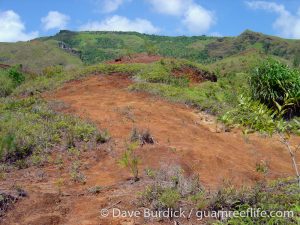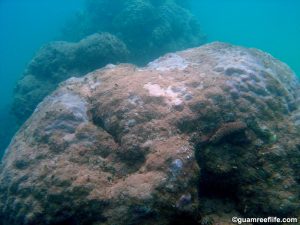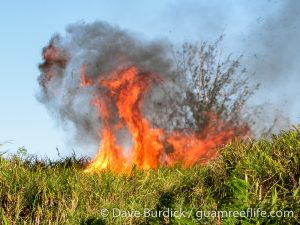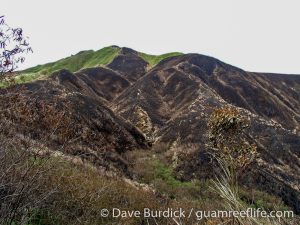
What is sedimentation and how does it affect coral reefs?
Sedimentation is one of the greatest threats to the vitality of Guam’s coral reefs. Sedimentation occurs when sediment – mainly clayey soil from the uplands in southern Guam – is washed into rivers during rain events and out into the nearshore waters, where it falls on corals and other benthic organisms. In large enough amounts, the sediment can bury and smother the coral, killing it. But even in smaller amounts, sediment causes excess stress to the corals, by forcing the corals to expend energy to remove the sediment. Many corals can remove sediment by sloughing off their mucus layer, to which the sediment sticks when it falls on the coral. But producing this mucus layer is costly, in terms of energy – energy which could otherwise be used to grow, reproduce, or possibly defend against infection by diseases. A recent study has also found that organic matter present along with the sediment in the riverine discharge may also damage the coral, perhaps by serving as a food source for dangerous pathogens naturally occurring within the coral mucus layer that may otherwise have been kept in check.

How has sedimentation affected Guam’s reefs?
It is difficult to describe the vast impact of sedimentation to Guam’s reefs – unless you see it for yourself. There are large areas of reef in southern Guam that are essentially wastelands, and could be considered ecologically extinct. Fleshy algae, cyanobacteria, and thick turf algae laden with sediment cover vast areas of reef once dominated by living corals. The reef is no longer growing in these areas, and the forces of erosion slowly chip away at the reef structure, reducing the complexity of the reef and decreasing the amount of habitat available for fish and other reef organisms. But with that said, sedimentation really only affects those reefs between Asan and Merizo on the west coast, and between Pago Bay and Merizo on the east coast. Reefs occurring north of these areas are not located near enough to any rivers to be significantly impacted by sediment or other pollution present in riverine discharge.
 What causes sedimentation on Guam’s reefs?
What causes sedimentation on Guam’s reefs?
As with many of the threats described on this site, sedimentation is a result of human activities. For exampled, perhaps one of the single most detrimental activity was the improper construction methods utilized by the Department of Works during the construction of Route 2 in the late 1980s/early 1990s. Researchers from the University of Guam Marine Lab documented wide-spread coral mortality across a 10-kilometer stretch of reef in southwestern Guam. Any visitors to reefs in this area will be hard-pressed to find a healthy reef, or even a moderately healthy reef. Even now, most of the reef area between Agat and Merizo is in poor to fair condition. While other threats, such as crown of thorns outbreaks, have likely caused coral mortality, sedimentation is a continuing, chronic problem in southern Guam that will require a significant commitment of resources to adequately address.

